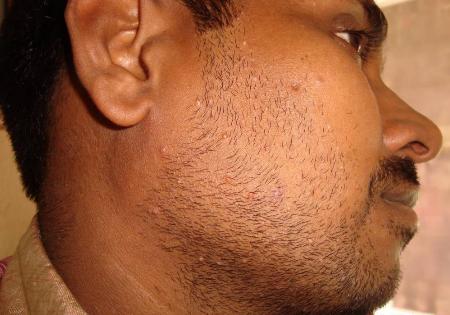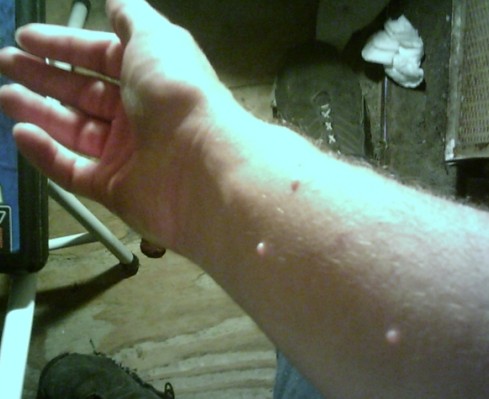We’ll show you some molluscum contagiosum pictures so you can see what the condition looks like. Keep in mind the fact that it may vary in appearance based on several factors, including your skin tone, the severity of the condition, and whether or not you’ve been scratching the affected areas.
Other skin conditions that may look somewhat similar to molluscum include warts and boils. You can visit our section on warts to see what they look like and our section on boils to see some pictures of those. If you’re not sure what you’re dealing with, we recommend seeing your physician for a diagnosis. Different skin conditions respond to different treatments and they are also spread in different ways, so it’s important to know whether you’re dealing with molluscum or something else.
What Does Molluscum Contagiosum Look Like?
As you’ll see from these molluscum pictures, molluscum contagiosum causes small flesh-colored bumps on the skin. They can range in size from the size of a pinhead to the size of a pencil eraser. They are often described as pearl-like and may resemble small blisters.
Molluscum bumps can appear anywhere on the body(1). You may have them in just one area or they may appear in many areas of your body. On children, the bumps are often found on the face, neck, arms, and hands. On adults, they are often found on the abdomen, upper thighs, and buttocks. They can also be found on the genitals, in which case they can be spread to others through sexual contact. If you have unusual bumps or lesions on your genitals and aren’t sure what’s causing them, we encourage you to see your doctor in case you have a sexually transmitted infection that requires medical treatment.
You may have just a few bumps or you may have so many they are hard to count.
If you’ve been scratching the affected area, it may look red and inflamed. If your scratching has broken the skin, there may be some scabs there. Although the condition can be itchy, it’s important to try not to scratch because scratching can cause the condition to spread and can also lead to secondary bacterial infections.
Molluscum Contagiosum Pictures
Here are some molluscum contagiosum pictures so you can see what the condition looks like. You can see how some people have more bumps than others and how the bumps can vary in size.

If you’ve got a skin condition that somewhat resembles these photos but you’re not sure if it’s molluscum contagiosum or not, we recommend seeing your physician find out for sure.

Treating Molluscum Contagiosum
If you’ve viewed these molluscum contagiosum pictures and are suffering from the condition yourself, you should know that it usually clears up without any treatment. However, that usually takes six to 12 months. Many people prefer to treat the condition because it can be itchy and uncomfortable and because it’s highly contagious and they don’t want to spread it to others.
Doctors sometimes prescribe topical or oral medications to treat molluscum. These are generally effective but can cause side effects. In other cases, doctors suggest freezing off the bumps (cryotherapy) or scraping them off (curettage). Cryotherapy and curettage are usually painful and may also cause scarring. In some cases, the benefits of those treatments outweigh the risks. In other instances, people prefer to use natural remedies or to simply allow molluscum to heal by itself, despite the lengthy healing process. Talk with your doctor if you have any questions about the best treatment option for you.
We like a natural remedy for molluscum called Naturasil. It contains plant extracts with antiviral properties that fight the infection without pain or scarring. While it is gentle, it is also effective and helps speed the healing process. Follow this link to learn more about Naturasil and see if it might be right for you.
